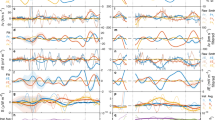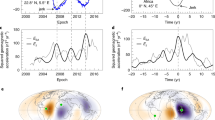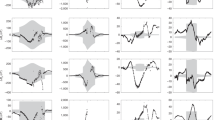Abstract
Modern observations of the geomagnetic field reveal fluctuations1,2,3 with a dominant period of about 60 years. These fluctuations are probably a result of waves in the liquid core4, although the precise nature of the waves is uncertain. Common suggestions include a type of magnetic wave, known as a torsional oscillation5, but recent studies6 favour periods that are too short to account for a 60-year fluctuation. Another possibility involves MAC waves7, which arise from the interplay between magnetic, Archimedes and Coriolis forces. Waves with a suitable period can emerge when the top of the core is stably stratified. Here I show that MAC waves provide a good description of time-dependent zonal flow at the top of the core8, as inferred from geomagnetic secular variation9. The same wave motion can also account for unexplained fluctuations in the dipole field10. Both of these independent predictions require a 140-kilometre-thick stratified layer with a buoyancy frequency comparable to the Earth’s rotation rate. Such a stratified layer could have a thermal origin11,12, implying a core heat flow of about 13 terawatts. Alternatively, the layer could result from chemical stratification13,14. In either case, the existence of a stratified layer at the top of the core obscures the nature of flow deeper in the core, where the magnetic field is continually regenerated.
This is a preview of subscription content, access via your institution
Access options
Subscribe to this journal
Receive 51 print issues and online access
$199.00 per year
only $3.90 per issue
Buy this article
- Purchase on Springer Link
- Instant access to full article PDF
Prices may be subject to local taxes which are calculated during checkout




Similar content being viewed by others
Change history
26 March 2014
Minor edits were made to the symbols in the keys of Fig. 4.
References
Currie, R. G. Geomagnetic line spectra—2 to 70 years. Astrophys. Space Sci. 21, 425–438 (1973)
Roberts, P. H., Yu, Z. J. & Russell, C. T. On the 60-year signal from the core. Geophys. Astrophys. Fluid Dyn. 101, 11–35 (2007)
Jackson, L. P. & Mound, J. E. Geomagnetic variation on decadal time scales: what can we learn from empirical mode decomposition? Geophys. Res. Lett. 37, L14307 (2010)
Finlay, C. C., Dumberry, M., Chulliat, A. & Pais, M. A. Short timescale core dynamics: theory and observation. Space Sci. Rev. 155, 177–218 (2010)
Braginsky, S. I. Torsional magnetohydrodynamic vibrations in the Earth’s core and variations in day length. Geomagn. Aeron. 10, 1–10 (1970)
Gillet, N., Jault, D., Canet, E. & Fournier, A. Fast torsional waves and strong magnetic field with the Earth’s core. Nature 465, 74–77 (2010)
Braginsky, S. I. MAC-oscillations of the hidden ocean of the core. J. Geomag. Geoelectr. 45, 1517–1538 (1993)
Jackson, A. Time dependency of tangentially geostrophic core surface motion. Phys. Earth Planet. Inter. 103, 293–311 (1997)
Bloxham, J. & Jackson, A. Time-dependent mapping of the magnetic field at the core-mantle boundary. J. Geophys. Res. 97, 19537–19563 (1992)
Yokoyama, Y. & Yukutake, T. Sixty-year variation in a time series of the geomagnetic gauss coefficients between 1910 and 1983. J. Geomag. Geoelectr. 43, 563–584 (1991)
Pozzo, M. Davies, C. Gubbins, D. & Alfe, D. Thermal and electrical conductivity of iron at Earth’s core conditions. Nature 485, 355–358 (2012)
Pozzo, M., Davies, C., Gubbins, D. & Alfe, D. Transport properties for liquid silicon-oxygen-iron mixtures at Earth’s core conditions. Phys. Rev. B 87, 014110 (2013)
Buffett, B. A. & Seagle, C. T. Stratification at the top of the core due to chemical interaction with the mantle. J. Geophys. Res. 115, B04407 (2010)
Gubbins, D. & Davies, C. J. The stratified layer at the core-mantle boundary caused by barodiffusion of oxygen, sulphur and silicon. Phys. Earth Planet. Inter. 215, 21–28 (2013)
Zatman, S. & Bloxham, J. Torsional oscillations and the magnetic field within the Earth’s core. Nature 388, 760–763 (1997)
Buffett, B. A., Mound, J. E. & Jackson, A. Inversion of torsional oscillations for the structure and dynamics of Earth’s core. Geophys. J. Int. 177, 878–890 (2009)
Christensen, U. R. Geodynamo models: tools for understanding properties of Earth’s magnetic field. Phys. Earth Planet. Inter. 187, 157–169 (2011)
Buffett, B. A., Matthews, P. M. & Herring, T. A. Modeling of nutation and precession: effects of electromagnetic coupling. J. Geophys. Res. 107, B42070 (2002)
Koot, L. et al. Constraints on the coupling at the core-mantle and inner-core boundaries inferred from nutation observations. Geophys. J. Int. 182, 1279–1294 (2010)
Holme, R. & Olsen, N. Core surface flow modeling from high-resolution secular variation. Geophys. J. Int. 166, 518–528 (2006)
Jackson, A., Jonkers, A. R. T. & Walker, M. R. Four centuries of geomagnetic secular variation from historical records. Phil. Trans. R. Soc. Lond. A 358, 957–990 (2000)
Wardinski, I. & Lesur, V. An extended version of the C3FM geomagnetic field model: application of a continuous frozen-flux constraint. Geophys. J. Int. 189, 1409–1429 (2012)
Gubbins, D., Thomson, C. J. & Whaler, K. A. Stable regions in the Earth’s liquid core. Geophys. J. R. Astron. Soc. 68, 241–251 (1982)
Labrosse, S., Poirier, J. P. & LeMouel, J. L. On the cooling of the Earth’s core. Phys. Earth Planet. Inter. 99, 1–17 (1997)
Lister, J. R. & Buffett, B. A. Stratification of the outer core at the core-mantle boundary. Phys. Earth Planet. Inter. 105, 5–19 (1998)
Kuang, W. & Bloxham, J. Numerical modeling of magnetohydrodynamic conv6ction in a rapidly rotating spherical shell: Weak and strong field dynamo action. J. Comput. Phys. 153, 51–81 (1999)
Sorensen, D. C. Implicit application of polynomial filters in a k-step Arnoldi method. SIAM J. Matrix Anal. Appl. 13, 357–385 (1992)
Eymin, C. & Hulot, G. On core surface flows inferred from satellite magnetic data. Phys. Earth Planet. Inter. 152, 200–220 (2005)
Finlay, C. et al. International geomagnetic reference field: the eleventh generation. Geophys. J. Int. 183, 1216–1230 (2010)
Fox, L. & Parker, I. B. Chebyshev Polynomials in Numerical Analysis (Oxford Univ. Press, 1968)
Buffett, B. A. Chemical stratification at the top of Earth's core: constraints from observations of nutations. Earth Planet. Sci. Lett. 296, 367–372 (2010)
Jault, D. Axial invariance of rapidly varying diffusionless motion in the Earth's core interior. Phys. Earth Planet. Inter. 166, 67–76 (2008)
Acknowledgements
A. Jackson and I. Wardinski provided models of surface core flow and magnetic field. Comments and suggestions from R. Holme substantially improved the final text. This work was supported in part by the US National Science Foundation (EAR-1045277).
Author information
Authors and Affiliations
Corresponding author
Ethics declarations
Competing interests
The author declares no competing financial interests.
Extended data figures and tables
Extended Data Figure 1 Azimuthal velocity Vϕ on a meridional cross-section.
Wave motion in the stratified layer at the top of the core induces geostrophic flow in the underlying fluid. The geostrophic nature of the deeper flow is inferred from the axial independence of the velocity.
Extended Data Figure 2 Radial velocity along a radial transect at colatitude θ = 40°.
Radial motion is confined to the stratified layer and vanishes in the nearly geostrophic interior.
Rights and permissions
About this article
Cite this article
Buffett, B. Geomagnetic fluctuations reveal stable stratification at the top of the Earth’s core. Nature 507, 484–487 (2014). https://doi.org/10.1038/nature13122
Received:
Accepted:
Published:
Issue Date:
DOI: https://doi.org/10.1038/nature13122
This article is cited by
-
A hydrogen-enriched layer in the topmost outer core sourced from deeply subducted water
Nature Geoscience (2023)
-
Primordial helium extracted from the Earth’s core through magnesium oxide exsolution
Nature Geoscience (2023)
-
Quasi-geostrophic MHD equations: Hamiltonian formulation and nonlinear stability
Computational and Applied Mathematics (2023)
-
The core-merging giant impact in Earth’s accretion history and its implications
Acta Geochimica (2022)
-
Geomagnetic secular variation consequences on the trajectories of radiation belt trapped particles
Astrophysics and Space Science (2022)
Comments
By submitting a comment you agree to abide by our Terms and Community Guidelines. If you find something abusive or that does not comply with our terms or guidelines please flag it as inappropriate.



